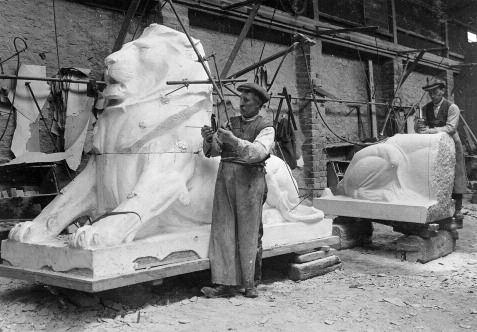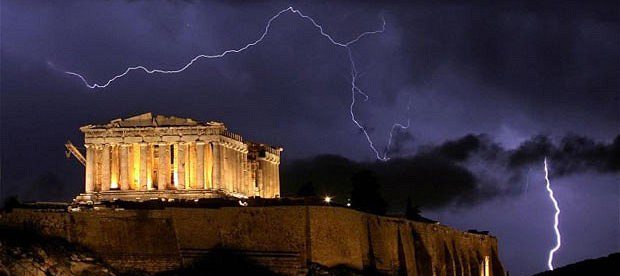Arthur Taylor ~ Froghall Granite Works
Arthur Taylor Granite Mason
Arthur Taylor’s Granite Yard was at 43–Jute Street and it was from this Yard that James Philip produced Works of notable skill & Artistic Merit: including work for the Marine Engineer’s Memorial in Liverpool and the Inverurie War Memorial, as well as the Statue of Edward VII in Aberdeen.
Carved by Mason James Philip with his assistant George Cooper. Pneumatic & Hand chisels were used in the cutting of this Kemnay Granite Sculpture. The Lead Mason, James Philip, spent his working life in the Granite Yard of Arthur Taylor and he was perhaps the best Carver ever employed in the City’s Stone Trade.
In 1897 Taylors Yard employed the 1st 2-Mechanical Pneumatic Hammers (more than 5,000 strokes per min) which had been used in this way in the Country. In 1900 Mr Taylor presented the hammers to the Aberdeen Mechanical Society.
An 1899 Article “MacCoy’s Pneumatic Tool Recommended for the Award of the Scott Medal”, devised by James S MacCoy; and manufactured by American Pneumatic Tool Company, 431 Eleventh Avenue, New York. This Article also features 3-halftone illustration of the MacCoy’s Pneumatic Tools. Fig 1-to 6 shows the MacCoy’s Pneumatic Tool. Fig. 7 shows the MacCoy’s Repousse Machine. Fig 8 shows various applications of the Pneumatic Tool.
The Pneumatic Tool had been in use for a considerable time in England for caulking purposes, but the people of the USA were the 1st to apply it to Granite, the Pioneers of this idea being, it is asserted, Scottish-Americans. Broadly speaking, a Pneumatic Tool is a small cylinder within which a piston is driven by compressed air. The motion of the Piston being communicated to an ordinary Carving Chisel, that Tool when in use comes in contact with the Stone at the rate of from 1,500 to 2,000 strokes per min, very many more times, it will be admitted, than a Workman could accomplish with an ordinary Hammer.
The air is generated by a Steam Compressor, and conveyed by Metal Pipes to the Carving Sheds. These Pipes are tapped at intervals, and the Air carried by Flexible-Rubber Tubes to the Tools held in the hands of the Workmen. When directed by a skilful Craftsman the Pneumatic Tool will accomplish work of the most minute & elaborate detail. When applied to the Stone it rapidly “eats” away at the superfluous material, and flowers, fruit, heraldic shields, regimental crests, & Designs of a like nature, are quickly reproduced on the hard Granite, with as much fidelity of detail as could be accomplished in Sicilian Marble.
For Statuary, the Pneumatic Chisel is equally useful, and it is also extensively applied in the cutting of Inscriptions. There are Pneumatic Surfacing Machines for dressing Large Stones, but only a few were as yet in use in Aberdeen. The Axe and the Bush-hammer are the Tools most extensively in use for fine Dressing. When the dressing of Stone is done entirely by hand a considerable amount of Labour is necessarily expended before the roughness of the Quarry gives place to the smooth surfaces and the sharp & true edges required by finished Work.

Masons James Philip & George Cooper Carving the War Memorial Lion, c.1924. To transfer Measuring Points from the Clay Model to a Block of Granite, the Sculptor usually takes 3-Reference Points on both Model & Block. By using these points a Sculpture can be measured accurately, for the 3-Directions of measuring – width, height & depth – are thus defined. These 3 Measuring Points are traditionally used by Sculptors to Copy a Sculpture with a Pointing Machine. In using the Pointing Machine, the Sculptor mounts or glues 3 metal rivets, that correspond to each other, on both Model & Block of Granite. To these basic points, a (usually wooden) T-shaped support is hooked up, – the Cross. On this Cross Wood, the actual pointing device is attached. The Sculptor sets the device by moving the Arms of the Tool so that the point of the needle just touches the Point to be measured on the Model. The needle is set at a right angle to the surface that is measured and the stop is tightened. The Sculptor then takes the whole Cross, Pointing Machine and all, to the Block of Granite and sets it up on the identical, corresponding basic points. The needle that defines the measuring point can slide. By subsequently carving or Drilling carefully until the needle touches the stop, the Sculptor can place their measuring point exactly on the Block. By thus copying several 100’s of points, an accurate copy can be carved. The quality of the Copy will still depend on the Skill of the Sculptor, however, because these points are only the basis for the Final Sculpture. The real advantage is the need to measure each point only once, instead of 3-times with Callipers (once each for height, width & depth). Also, there is no need to read Scales in inches, and consequently, there is less room for error. Usually, the Sculptor will make their own Cross Wood. The Lion Sculpture was designed by William MacMillan, ARA, from Aberdeen. It was sculpted in Arthur Taylor’s Granite Yard in Jute Street using Kemnay Granite by Lead Mason James Philip, assisted by George Cooper.
Aberdeen’s most Elaborate Granite Sculpture was Designed by Alfred Drury RA and Carved by James Philip.

On a Plinth of Polished Red Peterhead Granite the Sovereign holds a Sceptre with the Cross & an Orb. Edward wears the Robes of the Order of the Garter, the most Senior & Oldest Order of British Chivalry. Below the statue is a bronze ornamental frieze. To the left is the Figure of Peace, Britannia, breaking a Sword. In the Centre stands Scotland’s Patron Saint, Andrew and his Shield. Positioned on the right are 3-Figures called “Imperial Unity”. Britannia is seated centrally with her left arm encircling a Figure emblematic of the Indian & African Peoples. A 3rd Figure representing Canada & Australia extends a hand of Friendship to be kissed by “The Mother of Nations”. The Motto “Honi soit qui mal y pense” translates as “Shame on him who thinks this Evil”.

The reputation of Alfred Drury as one of the most able and original of our latter-day Sculptors will certainly be increased” by the excellence of his most excellent work, the Memorial to King Edward VII, which was Erected at Aberdeen. In his Design for this Memorial he has with sound judgment aimed at an effect of Dignified simplicity, and has avoided anything which might interfere with the Monumental character of his Work. He had treated the whole thing with an admirable sense of decorative Propriety and with a true perception of what are the greater essentials in Sculpture of this type. What he has specially kept in view in choosing his manner of treatment is the situation the Memorial is to occupy – an open space surrounded” by very large Buildings against which anything but simple and firmly planned forms would look trivial & unconvincing – he has allowed the Exigencies of the Site to guide him in arranging not only the general masses of the Monument but also the decorative details which have been introduced. Both the Colossal Statue of the King and the Pedestal on which it stands are of Granite; the flanking Groups, Unity & Peace, are in Bronze, but Drury has intentionally handled them with particular reticence & breadth so as to keep them in right relation to the largely Designed Figure of the Late King.







